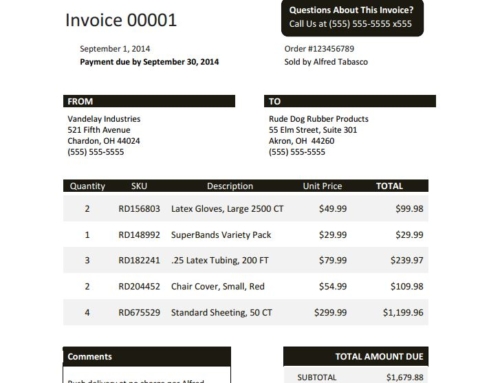INTRODUCTION
Days sales outstanding is the key performance indicator of most businesses for the accounts receivable department. But is it really the best metric to give an all encompassing view of one of the largest assets in your business? This whitepaper will explain what days sales outstanding is and what it is used for, how to calculate DSO, why there are problems associated with using DSO, and what other calculations you can use to supplement where it fails.
WHAT IS DAYS SALES OUTSTANDING?
Accounts receivable days sales outstanding (DSO) is a widely used method to help evaluate how effective a company is at collecting receivables. This metric is used to measure the average number of days it takes a company to collect what is owed to them after a sale has been completed. Put in fewer words, it is the average collection period. There is much to know about measuring and interpreting DSO, and we have a few words of caution as well when analyzing DSO.
Your ability to quickly collect outstanding accounts receivable has a direct impact on cash flow. Since cash plays a fundamental role in operations and growth, it is important to know how effective and efficient your company is in collecting that money so it can be reinvested back into the business.
HOW TO CALCULATE DSO
Accounts receivable days sales outstanding is an extremely common calculation to use as a benchmark for performance. Usually, a controller or CFO will look at this number as a way to gauge how well the accounts receivable department is doing their job, as this calculation will tell you how effective a company is at collection on open lines of credit. Usually the DSO calculation is applied to all outstanding invoices. The calculation can be used in many different ways than the standard, however. If you are lending credit to a customer and you are having issues with them paying, you can apply the DSO calculation at the customer level to get an idea of their cash flow troubles. The calculation can also be used to monitor internal amounts of cash invested in accounts receivable.
You can calculate DSO using the following formula:
(Accounts Receivable/Annual revenue) X Number of Days in the Year.
HOW TO INTERPRET AR DSO
Each industry has different standard payment terms so it is not possible to say that every company should have a DSO of “X”. Do some research on your days sales outstanding industry average and see where you measure up.
- A low DSO is an indicator that a company is collecting receivables quickly; generally this is a positive sign.
- A high DSO proves that a company takes longer to collect on credit sales and can indicate current or impending cash flow problems, operational issues, or a lack of effort or focus on credit collections. A few of the ways to battle high DSO is by implementing accounts receivable management software, a proven tool for reducing DSO, changing your credit terms, or running more in depth credit checks before extending credit to customers.
Typically you want DSO to exceed your terms by no more than half. So if you operate on payment terms of 30 days and you’re seeing payment in 45 days, you’re doing pretty well. There are other ways to set goals and benchmark though, including using a best possible DSO calculation.
This calculation still has its flaws, though, and should not be seen as a “be-all, end-all” for the accounts receivable department.
THE PROBLEMS WITH AR DSO
Accounts receivable days sales outstanding is commonly used as a benchmark for efficiency and effectiveness. Especially when management reports are created, CFOs, CEOs and owners are looking towards this key metrics to decide whether the accounts receivable department is doing their job well.
Unfortunately for the AR department, this key metric is extremely flawed and usually creates a bad reflection on what was actually collected.
Since the calculation for DSO typically includes the total amount sold and annual figures, this overlooks many factors the go into the accounts receivable department and affect how they collect. Below are a few examples of how DSO can be flawed.
SALES FOCUSED
The total amount of money collected is divided by the average sales per day. The average sales per day skews this calculation because it doesn’t take into account what types of new accounts these are. These could be a huge influx of customers that are offered poor receivables terms or discounted product. Additionally, the accounts receivable department is then rated on a calculation that includes a department they have no control over.
SEASONALITY
When comparing DSO from 6 months ago to the current DSO, this can make an accounts receivable department look like they aren’t doing a very good job, when, in reality, they simply don’t have as much to collect on. If a company is highly seasonal, there sales will be higher during one or two quarters of the year, then drop off for the rest of the year, making a DSO comparison look like there has been a massive change.
Take, for example, a company that supplies ski equipment to ski lodges. Their peak season will probably be from October to March. For the rest of the year, they probably aren’t making a ton of sales. This will make their quarterly comparisons look dramatically different simply because there is a huge increase in sales.
KEEP IN MIND
- DSO fluctuates with revenue and other short-term changes. For example, if your sales increase and your past due receivables stay the same in a month, your DSO will go down- but in this situation that does not mean your collection efforts have become more efficient. For this reason DSO should not be used as the only indicator of success or failure.
- DSO can be affected due to short-term fluctuations in sales or collections, best practices dictate that companies should compare DSO to past periods quarterly or annually to allow enough time between measurement dates for an accurate reflection and interpretation.
- Because of its tendency to fluctuate, analyzing DSO on a period less than a year can be misleading.
- DSO takes into account only credit sales, not cash sales.
- Always look at your DSO with context with your company’s terms.
Using DSO as a key metric can be problematic and not truly reflect the effectiveness (or ineffectiveness) of your accounts receivable team. DSO should always be used in conjunction with other key metrics that will give a wide view of how well the accounts receivable department is doing.
OTHER IMPORTANT ACCOUNTS RECEIVABLE METRICS
Days Sales Outstanding is not a clear indicator of how the entire accounts receivable team is doing on collections. Since DSO relies on total sales for the time period in question, the final DSO can be skewed. If a business using the calculation relies on a highly seasonal sales cycle, DSO will not be indicative of how well the accounts receivable team is actually doing in collections. Factors such as high volume sales at a discounted price and what the credit terms of the sales were all need to be evaluated.
This isn’t to say that DSO should be completely trashed as a calculation to use in the accounts receivable department. Often times a CFO or CEO wants to see this number in management reports. What should be done, however, to ensure that all factors are accounted for and a clear view of the accounts receivable department is portrayed is to couple the DSO calculation with other key indicators. Below, we’ve highlighted some additional calculations that give a more rounded view of effectiveness in collections efforts.
AVERAGE DAYS LATE
The average days late calculation gives insight into how many invoices are paid a certain time period past the due date. By using this calculation, you can see how often the accounts receivable department is allowing customers to pay 15 days late, 30 days late, 60 days late of 90 plus days late. The more that are in the latter categories, the more you should look into working on the methods of the department. Average days late can be calculated by subtracting the day the invoice was paid by the day it was due. This would be calculated for every invoice on a customer account and can be averaged for the entire account to see which customers pay late most often.
COLLECTION EFFECTIVENESS INDEX
The collection effectiveness index looks at what can be collected because it is currently due, as opposed to what is simply an open invoice and likely won’t be collected on as DSO does. When using the CEI calculation, 100 is a perfect score, but a company can exceed that if they are collecting on accounts before they come due. Collection effectiveness index can be calculated using the following formula:
[vc_single_image image=”3181″ img_size=”full” alignment=”center”][vc_single_image image=”3183″ img_size=”full” alignment=”center”]




